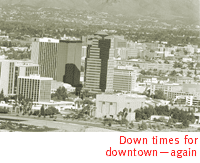
Is Development At Rio Nuevo Really A Magic Bullet?
By Dave Devine
FOR MORE THAN 40 years, downtown Tucson has been searching for
a magic bullet to "save" it from the ravages inflicted
by an ever-sprawling community. While a series of mini-downtowns
have sprung up around town as Tucson spread out over hundreds
of square miles of desert, the original city center continues
to deteriorate. But many downtown boosters still hold out hope
that one special project will restore the city center to its once-prominent
place in the community.
The same dream of a magic bullet solution was true in 1955, when
a proposal was made to relocate the railroad tracks out of the
area to create more land to develop. It held through the urban
renewal program of the 1960s, which promised that ridding downtown
of "blighted" homes and businesses and replacing them
with new government buildings was the answer.
 The solution to downtown's problems in the 1970s was supposed
to be La Placita Village, which promised to bring retail uses
back to the area. During the 1980s, the City of Tucson thought
that a privately funded office tower on city-owned land would
locate additional workers downtown, but there wasn't enough market
demand to justify building the high-rise.
The solution to downtown's problems in the 1970s was supposed
to be La Placita Village, which promised to bring retail uses
back to the area. During the 1980s, the City of Tucson thought
that a privately funded office tower on city-owned land would
locate additional workers downtown, but there wasn't enough market
demand to justify building the high-rise.
The newest magic bullet to save downtown is the collection of
proposals for Rio Nuevo, particularly Daystar Development's $420
million plan to build a big retail center and museum complex.
But how is a development almost one mile to the west going to
help the existing downtown? There's plenty of warm, fuzzy talk
of uniting the old and new parts of downtown through "linkages"
and "synergy," but in Tucson those concepts never seem
to pan out.
While Daystar's drawings of the Rio Nuevo proposal are pretty
on paper, the current downtown is on another downward spiral.
While nightclubs are on the rebound, retailers are fleeing the
area. During the day, most of the people walking down Congress
are downtown employees or beggars looking for change.
Still, some elected officials and downtown promoters want to
risk millions of taxpayer dollars in hopes of "saving"
the area through another magic bullet project. But the history
of downtown doesn't offer much encouragement along those lines.
Before the city government creates a stadium district at Rio
Nuevo, a few issues need to be considered. First, what downtown
are we talking about "saving"? The Daystar proposal
for Rio Nuevo, if ever built, would basically replace the existing
downtown with a new one. While the idea of a disposal downtown
is in keeping with our community values, is that really what Tucson
wants?
 And what's being done to help those retailers, artists and others
still sticking it out downtown? Using local sales tax revenues
to pay for parking near Fourth Avenue may not be as sexy as the
Rio Nuevo tax-increment-financing proposal, but it would be an
effective solution to a long-standing problem. Getting the government
out of the warehouse-management business along Toole Avenue would
be another way to help the area.
And what's being done to help those retailers, artists and others
still sticking it out downtown? Using local sales tax revenues
to pay for parking near Fourth Avenue may not be as sexy as the
Rio Nuevo tax-increment-financing proposal, but it would be an
effective solution to a long-standing problem. Getting the government
out of the warehouse-management business along Toole Avenue would
be another way to help the area.
The city of Tucson calls downtown "everyone's neighborhood"
and wants to do things in a big way to "save" it. But
maybe it's time to be cautious before spending lots of tax money
in the area. As history has shown, the magic bullets of the past
intended to "save" downtown Tucson have always missed
their mark.

|





